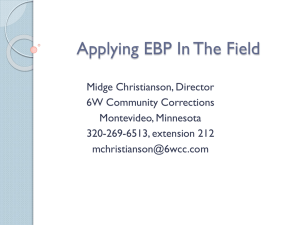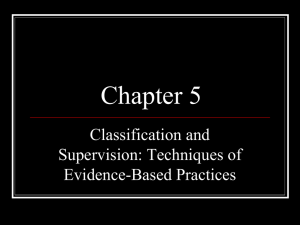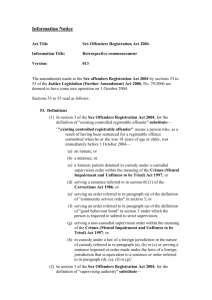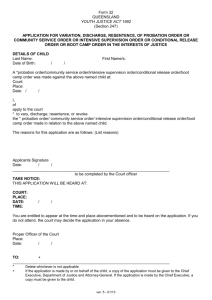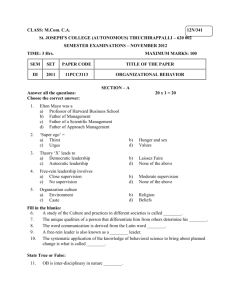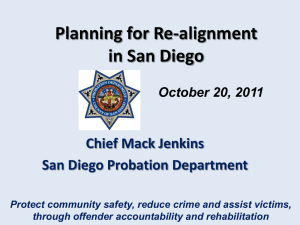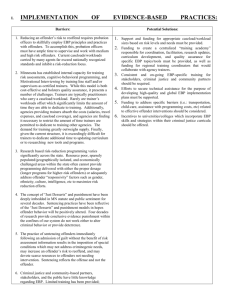Probation's Risk-Needs Assessment in a Nutshell Jamie Markham
advertisement
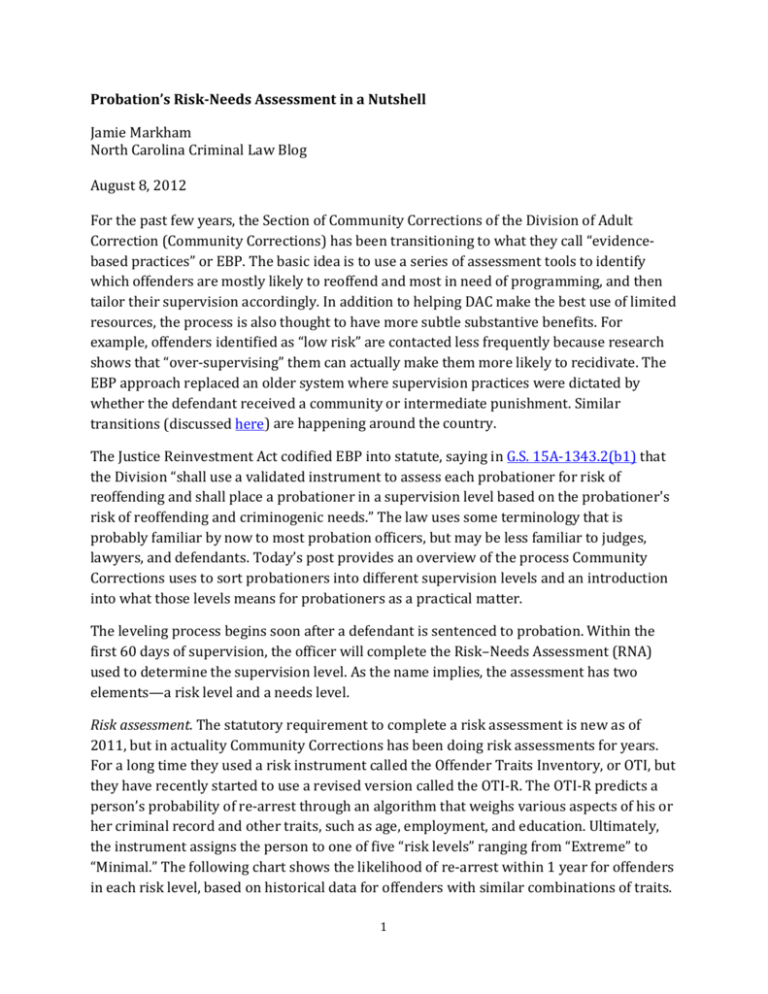
Probation’s Risk-Needs Assessment in a Nutshell Jamie Markham North Carolina Criminal Law Blog August 8, 2012 For the past few years, the Section of Community Corrections of the Division of Adult Correction (Community Corrections) has been transitioning to what they call “evidencebased practices” or EBP. The basic idea is to use a series of assessment tools to identify which offenders are mostly likely to reoffend and most in need of programming, and then tailor their supervision accordingly. In addition to helping DAC make the best use of limited resources, the process is also thought to have more subtle substantive benefits. For example, offenders identified as “low risk” are contacted less frequently because research shows that “over-supervising” them can actually make them more likely to recidivate. The EBP approach replaced an older system where supervision practices were dictated by whether the defendant received a community or intermediate punishment. Similar transitions (discussed here) are happening around the country. The Justice Reinvestment Act codified EBP into statute, saying in G.S. 15A-1343.2(b1) that the Division “shall use a validated instrument to assess each probationer for risk of reoffending and shall place a probationer in a supervision level based on the probationer's risk of reoffending and criminogenic needs.” The law uses some terminology that is probably familiar by now to most probation officers, but may be less familiar to judges, lawyers, and defendants. Today’s post provides an overview of the process Community Corrections uses to sort probationers into different supervision levels and an introduction into what those levels means for probationers as a practical matter. The leveling process begins soon after a defendant is sentenced to probation. Within the first 60 days of supervision, the officer will complete the Risk–Needs Assessment (RNA) used to determine the supervision level. As the name implies, the assessment has two elements—a risk level and a needs level. Risk assessment. The statutory requirement to complete a risk assessment is new as of 2011, but in actuality Community Corrections has been doing risk assessments for years. For a long time they used a risk instrument called the Offender Traits Inventory, or OTI, but they have recently started to use a revised version called the OTI-R. The OTI-R predicts a person’s probability of re-arrest through an algorithm that weighs various aspects of his or her criminal record and other traits, such as age, employment, and education. Ultimately, the instrument assigns the person to one of five “risk levels” ranging from “Extreme” to “Minimal.” The following chart shows the likelihood of re-arrest within 1 year for offenders in each risk level, based on historical data for offenders with similar combinations of traits. 1 OTI-R Score Range 0–10 11–25 26–49 50–65 66–100 Percent Re-Arrested within 1 year 7% 16 31 47 57 Risk Level Minimal Low Moderate High Extreme Needs assessment. Two assessment tools make up the “needs” portion of the RNA. They are the “Officer’s Interview/Impressions Worksheet” and the “Offender Self-Report.” These tools ask a battery of questions designed to flag a person’s “criminogenic needs.” Criminogenic needs are aspects of the defendant’s life that are generally linked to criminal behavior, such as associating with criminal peers, having a dysfunctional family, and substance abuse. Depending on the particular needs identified by the assessment tools and other factors (like a person’s juvenile record), DAC sorts offenders into one of five “needs levels” ranging from “Extreme” to “Minimal.” Supervision level. The results of the RNA—the risk instrument and two needs instruments—are blended together to determine an overall supervision level for the probationer. Offender Traits Inventory (OTI-R) Officer Interview & Impressions Offender Self Report Supervision Level (L1 – L5) 2 DAC sorts offenders into five supervision levels. Supervision Level 1 (L1) probationers are the most likely to reoffend and have the greatest need for programming, while Supervision Level 5 (L5) probationers are those who are least likely to reoffend. The chart below shows in greater detail how the results of the risk assessment and the needs assessment are correlated to determine the offender’s supervision level. As a matter of Community Corrections policy, certain offenders are subject to a minimum supervision level regardless of the results of the RNA. For example, offenders under supervision for a reportable sex crime; court-identified domestic violence offenders; Level One, Two or Three DWI offenders; and validated gang members are never supervised below L3. All probationers are supervised at L1 for the first 60 days of supervision until the leveling process is complete. Consequences of the supervision level. An offender’s supervision level dictates two principal aspects of the way he or she is supervised. First, the supervision level determines the frequency with which the probation officer must contact the offender. Officers must have at least one “Offender Management Contact” (a face-to-face contact in which the officer must, by policy, discuss certain things with the offender) per month with L1, L2, and L3 offenders. By contrast, L4 and L5 offenders are eligible for placement on a remote reporting system called Offender Accountability Reporting (OAR) that allows them to report via the internet or the mail. (Note that OAR is not the same as unsupervised probation. Remote reporters still have a probation officer and pay supervision fees, for example.) The table below shows the minimum contact standards applicable to each supervision level. Additional contacts may be required as directed by the court or the probation officer. 3 SUPERVISION LEVEL MINIMUM CONTACT STANDARDS L1 1 home contact and 1 offender management contact per month L2 L3 L4 1 home contact every 60 days and 1 offender management contact per month 1 home contact every 60 days and 1 offender management contact per month Remote report monthly and one face-to-face contact every 90 days L5 Remote report monthly Second, a probationer’s supervision level has a bearing on how the probation officer responds to alleged violations. The chart below, drawn from Community Corrections policy, shows the various types of response options that are permissible in response to a particular type of violation by a probationer within a particular supervision level. For any violation that implicates public safety by any level of offender, the officer should take response option A: file a probation violation report (PVR) and arrest the probationer. By contrast, an officer may only use response option B, the JRA’s new quick dip in the jail through delegated authority, in certain types of violations (a new criminal offense or recurring technical violations) by certain offenders (L1 or L2). That’s the process in a nutshell. When probation officers talk about “EBP” or “levels,” this is what they mean. The process raises all kinds of questions, but my goal here is simply to introduce the basic framework. Probation officers need to understand the process because 4 it is part of their guiding policy. It seems to me, though, that others should know about it, too. For example, a judge who wants to know more about a particular case might ask probation officer “What is the defendant’s risk level?” to get a quick sense of the person’s dangerousness or “Which criminogenic needs were identified?” to evaluate the appropriateness of certain programs or treatment options. Or a judge may wish to say that he or she does not want a person to be placed on remote reporting, regardless of the supervision level. For everyone, having a shared understanding and vocabulary about defendants’ risks and needs enables a higher level and (I hope) more effective conversation about how the system can achieve the best possible results—whatever one thinks the best result may be. 5

